<music: Vincent Igusa, bassoon, and Catherine Renggli, piano. Towson University Recital Hall, 20 June 2017.>
莫扎特的巴松管协奏曲,第七部分。裝飾樂段,第二篇—結束部分的寫作。Terry B. Ewell,数位巴松管教授。BDP #213。Vincent Igusa,巴松管,Catherine Renggli,钢琴。译者:許嘉宇。www.2reed.net
1. Welcome to our 7th video in the series on Mozart’s Bassoon Concerto. I am Terry Ewell.
1. 欢迎观看我们关于莫扎特巴松管协奏曲系列的第 7个视频。我是Terry Ewell.
2. Documents from Mozart’s time period and before indicate that many performers improvised their cadenzas, that is, they created the music at the moment. There are performers today who do this as well, and they are to be congratulated for this.
For me, however, the stress of just performing a prepared cadenza is enough. For this reason, ahead of time I carefully craft my composition.
2. 莫扎特时期及之前的文獻表明,许多表演者即兴创作了他们的华彩,即他们在演奏的當下创作了音乐。如今也有表演者这样做,我們将为他们对此表示慶幸。然而,对我来说,仅仅演奏准备好的华彩乐段的重要性已是足够的。为此,我提前精心制作了我的創作。
3. Let’s review quickly guidelines about the cadenzas:
1) Style. The cadenza should match the style of the music (harmony, melody, rhythms, expression, technical character)
2) Quotation. The cadenza should make use of materials contained in that movement of the concerto.
3) Brilliant passage work. The cadenza should showcase the performer’s abilities.
To this, you might want to add a fourth guideline.
3. 让我们快速回顾一下有关华彩樂段的指南:
1)风格。华彩乐段应与音乐风格(和声、旋律、节奏、表达、技术特征)
2)引用。华彩乐段应使用其中包含协奏曲裡的樂章的材料。
3)精彩乐段的作用。华彩乐段应该展示表演者的能力。
為此,你可能需要再增加第四條指南:
4) Historically informed. If desired, conform with historical “authenticity.”
4. For instance, you might want to limit the bassoon part to what could be played on an instrument from that time period. This would mean, for instance, limiting the high register range of the instrument to Bb4, the highest note that Mozart wrote in his concerto. Definitely the high F, F5, in Ibert’s cadenza would be ruled out!

4)历史信息。如果需要,需符合历史的“真实性”。
4. 例如,您可能希望将巴松管部分限制为在那个时期的乐器上演奏。这意味着,例如,将乐器的高音域范围限制为 Bb4,莫扎特在他的协奏曲中写下的最高音。那麼最高音 F,F5,在Ibert的华彩乐章绝对将被排除!
5. Examples of cadenzas from the Baroque and Classical periods are shorter in length than those found in the late 1800s and 1900s. For instance, consider this second movement cadenza written by Mozart for the A Major Mozart piano concerto. This cadenza is from a collection of thirty-six cadenzas written by Mozart. I encourage you to study them as you start writing your own cadenzas.
36 Cadenzen für das Pianoforte von W. A. Mozart, Köch. Verz. No. 624. Leipzig: Breitkopf und Härtel, 1878.
http://imslp.org/wiki/36_Cadenzas%2C_K.624%2F626a_
(Mozart%2C_Wolfgang_Amadeus)
5. 巴洛克和古典时期的华彩乐段的长度比 1800 年代后期和 1900 年代发现的要短。例如,可參考一下莫扎特为A大调钢琴协奏曲创作的第二乐章华彩乐段。这个华彩乐段来自莫扎特的三十六首华彩创作集。我鼓励您在开始编写自己的华彩乐段时研究它们。
6. In addition, I want to mention an article by composer and oboist John Corina on writing cadenzas. In his article he advocates writing a cadenza by adopting the harmonies created by Mozart in this collection and then using that harmonic framework to create a new cadenza. For instance, he takes the harmonies from Mozart’s cadenza number 15 and then uses them for the Mozart Oboe Concerto.
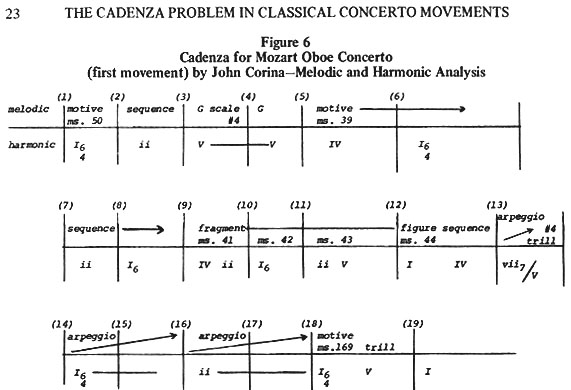
Corina, John. “The Cadenza Problem in Classical Concerto Movements,” Journal of the International Double Reed Society vol. 3 (1975). http://www.idrs.org/publications/controlled/Journal/JNL3/cadenza.html
6. 此外,我想提及作曲家兼双簧管演奏家约翰·科里纳 (John Corina) 撰写的一篇关于创作华彩乐章的文章。在他的文章中,他主张通过采用莫扎特在这个集合中创造的和声,然后使用那个和谐的框架来创造一个新的华彩乐段。例如, 他从莫扎特的第 15 号华彩乐段中提取和声,然后将它们用于莫扎特双簧管协奏曲。
7. You might find this approach quite helpful. However, I prefer an approach that is less prescribed, which is presented in this and the next video.
7. 您可能会发现这种方法很有帮助。但是,我更喜欢一种方法是较少规定的,在本视频和下一个视频中會來介绍。
8. For our purposes here, let’s consider our cadenza in three parts: 1) the opening statement, 2) the middle section which contains at least one sequence and other flourishes, and 3) the conclusion.
8. 为了我们的目的,在这里让我们分三个部分探討我们的华彩乐段:
1) 開頭句子
2) 包含至少一个序列和其他花样的中间樂段,以及
3)结尾
9. Instead of just writing the cadenza from the beginning to the end, I suggest that you try writing it from the end first. This might help your creative process. Let’s first consider the conclusion to the cadenza.
9. 与其只是从头到尾写华彩乐章,我建议您先尝试从尾段开始写。这可能有助于您的创作过程比較有創造力。让我们首先考虑华彩乐段的结论。
10. Notice how Mozart sets up the conclusion to these cadenzas. In the conclusion, there does not need to be a direct quotation from the Concerto, rather these sections feature florid scales and arpeggios in the style of the composition. In cadenza 1, a prominent A octave is given in the bass. This serves as a pedal tone and is on the fifth scale degree of D major, the key of this concerto. From that point a cadential 6/4 or dominant 7th chord is implied by the scale and the ending figure. The trill ends on a V7 chord leading to the tonic when the orchestra would enter.

10. 请注意莫扎特如何为这些华彩设置结尾。在結尾段,不需要直接引用协奏曲的素材,相反,这些部分可以以作品中华丽的音阶和琶音为特色。在华彩乐段 1 中,低音中有一个突出的 A 八度音程。这个作为持續音,在 D 大调的第五音上,剛好是这部协奏曲的原調。从那时起,音阶和结尾形式皆暗示了一个終止 6/4和弦或屬7 和弦。当管弦乐队进入时,颤音以屬七和弦结束而導入主音。
11. We find much the same approach given in the ending of the 15th cadenza. Notice that the dominant, here G, is emphasized in the bass, followed by arpeggiated figures for a cadential 6/4 chord which lead again to the V7 and the I.
11. 我们发现与第 15 个华彩乐段结尾处给出的方法大致相同。请注意,这里的屬音(此处的 G)在低音中得到强调,其次是 6/4 和弦的琶音的形式,再次通向屬七V7 和一級 I。

12. The 9th cadenza follows the same pattern as well.
12. 第 9 华彩乐段也遵循相同的模式。
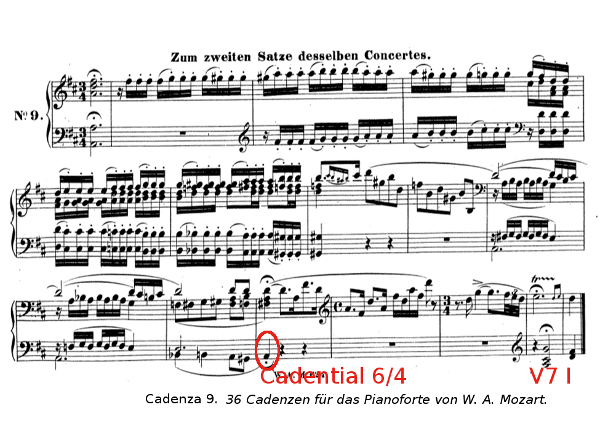
13. To create a cadenza ending, begin by identifying the dominant of the key signature and creating a pedal tone section that implies the harmony of cadential 6/4 or the dominant chord. Since single line instruments cannot provide the V7 during a trill, as Mozart does with the piano, I find that presenting the dominant or dominant 7th in this conclusion is particularly effective.
13. 要创造华彩乐段结尾,首先要确定调号的主导,然后创造一个持續音部分,暗示終止6/4和弦或屬和弦。由于单聲部乐器无法在颤音中提供屬七和弦,就像莫扎特对钢琴所做的那样,我发现在这个结论中呈现屬和絃或屬七和弦特别是有效果的。
14. In my cadenza, I create the dominant pedal tone area by first given a half note on F, which is the dominant of Bb, the key of the concerto. I then emphasize it in the lower octave to establish that F as the pedal tone of this last section. See the notes in the red box.
14. 在我的华彩乐段中,我首先在 F 上加了一个半音符来创造主要的持續音色区域,这是协奏曲的基调 Bb 的屬音。然后我在较低的八度中强调它以将 F 作为最后一部分的持續音。请参阅红色框中的注释。
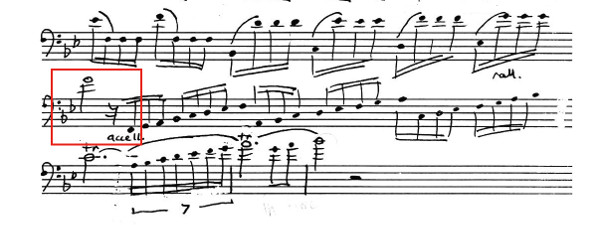
15. I then emphasize the dominant chord—F, A and C—throughout the conclusion. I have highlighted some of the chord members that are most heavily emphasized.
15. 然后我强调屬和弦,亦即F、A 和 C,來貫穿整個結尾。我强调了一些最重要的,那些被非常強調和弦音。
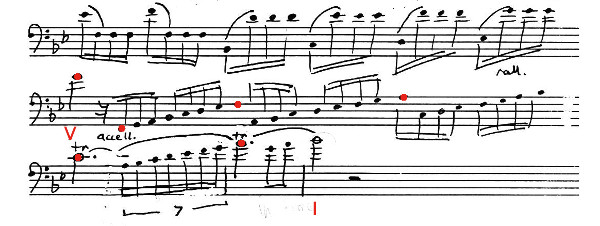
16. Vincent sets up the dominant pedal in a manner similar to my cadenza.
16. Vincent 以类似于我的华彩乐段的方式设置了屬和絃的持續音。
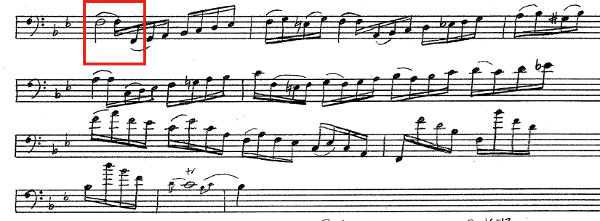
17. The harmony of his ending is, however, a bit more complicated. Much of the conclusion is devoted to the dominant chord through either metrically emphasized notes or arpeggios. Briefly, however, the cadenza returns to the Cadential 6/4 before implying the dominant seventh conclusion on the trill.
17. 然而,他结尾的和聲有点复杂。大部分结尾都致力于通过度量标准的屬和弦强调音符或琶音。然而,简而言之,华彩乐章回到終止6/4和弦是發生暗示颤音中屬七和弦的结束之前。
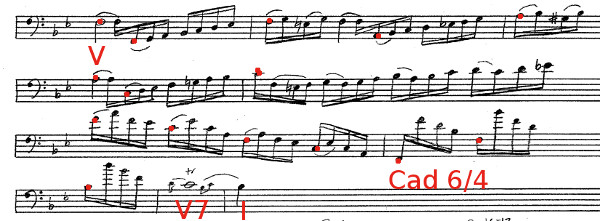
18. Now that you have seen several examples of conclusions to cadenzas, try writing a few now. Once you have done that you will be ready to view the next video where I will discuss writing opening statements and the middle sections of cadenzas.
18. 现在您已经看到了几个华彩的结论范例,现在可尝试写一些。完成后,您就可以查看下一个视频,我将讨论撰写开场的部分和中间的华彩乐段的部分。
<music: Vincent Igusa, bassoon, and Catherine Renggli, piano. Towson University Recital Hall, 20 June 2017.>
